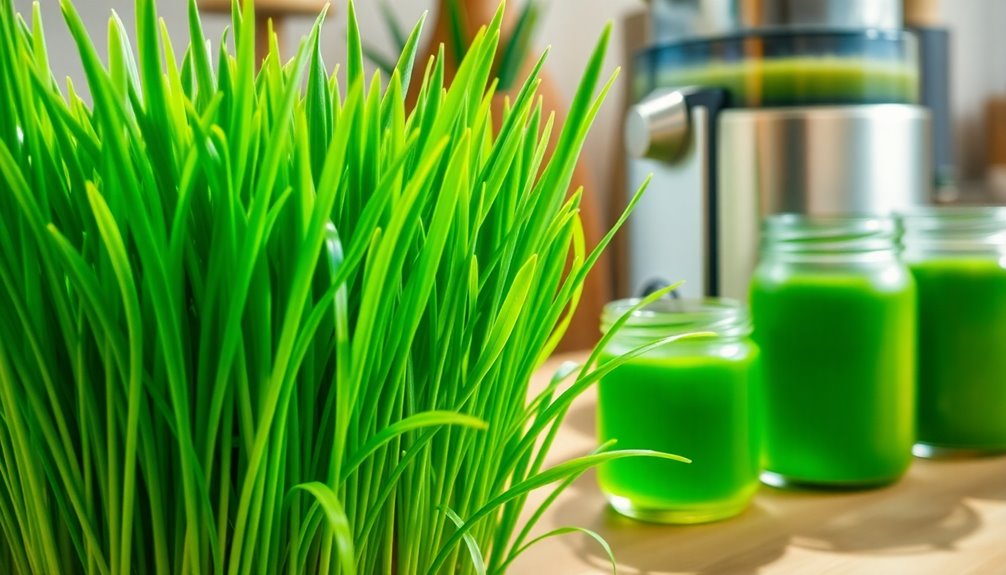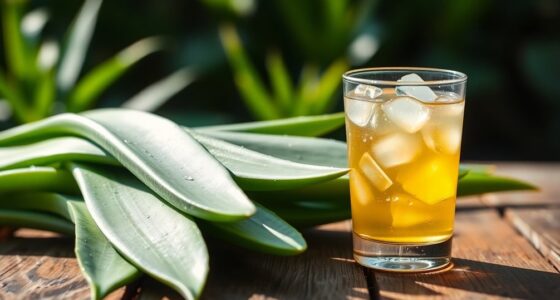Wheatgrass is a nutrient-packed powerhouse that can significantly enhance your health when juiced. It provides protein, essential amino acids, vitamins A, C, and E, and vital minerals like potassium and iron. Juicing fresh wheatgrass offers a potent source of antioxidants that boosts your immune system and aids detoxification. To master the art of juicing, you'll need the right equipment and techniques. Keep exploring to discover creative ways to incorporate this green gem into your diet!
Key Takeaways
- Wheatgrass is a nutritional powerhouse, rich in protein, vitamins, and essential minerals that support overall health and wellness.
- Use a high-quality masticating juicer to maximize juice yield and preserve nutrients.
- Harvest wheatgrass at 6-8 inches and juice immediately for optimal freshness and benefits.
- Incorporate wheatgrass juice into smoothies, dressings, and sauces for creative health boosts.
- Regularly consume wheatgrass juice to enhance immune function, detoxification, and antioxidant protection.
Understanding Wheatgrass and Its Nutritional Value

Wheatgrass is a powerhouse of nutrition, packed with essential vitamins, minerals, and amino acids that can significantly benefit your health. With up to 36.29 grams of protein per 100 grams of powder, it's an excellent source of plant-based protein. You'll also find about 49.23 grams of carbohydrates and 9.15 grams of dietary fiber, which support digestion and blood sugar control. Additionally, wheatgrass is high in total dietary fiber, contributing to its ability to help maintain blood sugar and cholesterol levels.
Rich in potassium, zinc, iron, and calcium, wheatgrass delivers essential minerals for your body. It boasts a diverse amino acid profile, including all nine essential amino acids, promoting overall protein efficiency. Additionally, it offers vital vitamins like A, C, and E, enhancing its nutritional value. Incorporating wheatgrass into your diet can truly elevate your wellness journey.
The Health Benefits of Wheatgrass Juice

Juicing wheatgrass unlocks a wealth of health benefits that can transform your well-being. This powerful green juice is packed with antioxidants, protecting your cells from damage and fighting oxidative stress. It also boosts your immune system, helping your body fend off infections. If you struggle with digestion, wheatgrass aids in detoxifying your gut and can alleviate constipation. Additionally, its high chlorophyll content functions as “green blood,” which promotes heart health and supports raw nutrition through its nutrient density. Your skin will thank you too, as its antibacterial properties support healthy skin cell growth and combat infections. Plus, the chlorophyll in wheatgrass enhances liver detoxification and blood health. With regular consumption, you may notice improved energy levels, cognitive function, and even weight management. Embrace the power of wheatgrass juice and experience these incredible benefits for yourself! In addition to the myriad advantages of wheatgrass juice, exploring other nutritious options can further enhance well-being. For instance, incorporating cranberry juice into your diet can provide notable cranberry juice health benefits for men, such as reducing the risk of urinary tract infections and supporting prostate health. By combining the benefits of both wheatgrass and cranberry juice, you can create a powerhouse beverage that promotes overall vitality and wellness.
Essential Equipment for Juicing Wheatgrass

When it comes to extracting the vibrant nutrients from wheatgrass, having the right equipment can make all the difference. You'll want a high-quality masticating juicer, as it effectively crushes and squeezes the fibers, maximizing juice yield. Freshly cut wheatgrass should be juiced immediately to retain its properties. Opt for a model made of durable 304 stainless steel, ensuring hygiene and longevity. If you prefer simplicity, a manual juicer is quiet, cost-effective, and doesn't require electricity.
Look for options that are easy to clean—dishwasher-safe or simple rinse types are ideal. For home use, compact models save space while still delivering great results. If you're considering commercial use, be prepared for more significant costs and maintenance. Always check for good customer support and warranty options for peace of mind.
Step-by-Step Guide to Juicing Wheatgrass

To get the most out of your wheatgrass, follow these simple steps to ensure a successful juicing experience.
First, harvest your wheatgrass when it reaches 6-8 inches tall for optimal nutrition. Thoroughly wash it to remove dirt and impurities, then chop it into small pieces for easier juicing. Inspect for mold and ensure it has a vibrant color before proceeding.
When it's time to juice, use a slow or specialized wheatgrass juicer for the best extraction. Alternatively, blend the chopped wheatgrass with water and strain it using a nut milk bag. Juicing with a juicer is often preferred for its efficiency in extracting juice.
Aim to consume your juice within half an hour for maximum benefits, and don't hesitate to dilute it with water for a better taste. Enjoy your health boost!
Tips for Growing Your Own Wheatgrass

If you're looking to boost your health with fresh wheatgrass, growing your own is a rewarding and straightforward process.
Start with high-quality wheat sprouting seeds and soak them in water for 8 hours to kick off sprouting. Use organic compost or enriched planting soil in a container with drainage holes. Optimal growth may require a warmer environment, so aim for temperatures between 60-80°F.
Maintain a warm sprouting environment between 60-80°F, rinsing the seeds 2-3 times daily for 2-3 days until small tails appear.
Once sprouted, spread them evenly over ½ to 1 inch of moistened soil, covering the tray to create darkness. Water daily, and once the grass reaches 1-2 inches, remove the cover.
Harvest when it's 4-6 inches tall, cutting just above the roots for regrowth. Enjoy your fresh wheatgrass!
Best Practices for Storing Wheatgrass Juice

Storing wheatgrass juice properly is essential for preserving its nutritional benefits and ensuring you get the most out of your health investment.
For maximum freshness, consume the juice immediately after juicing with a masticating juicer, as it retains the most nutrients. If you must refrigerate, store it in a small glass jar filled to the top, keeping it sealed to reduce oxidation. Aim to consume it within 24 hours, as nutrient loss increases beyond this timeframe, and wheatgrass juice can be stored for 24-48 hours in the refrigerator.
For long-term storage, freeze the juice in ice cube trays in portions of about 3-4 tablespoons. Cover the tray with a plastic bag to limit oxygen exposure.
Always check for spoilage signs before consumption, ensuring you enjoy the full health benefits of your wheatgrass juice.
Creative Ways to Incorporate Wheatgrass Juice Into Your Diet

While incorporating wheatgrass juice into your diet might seem challenging, it's actually quite simple and rewarding.
Start your day with a refreshing Wheatgrass Green Juice, blending it with spinach, green apple, cucumber, lemon, and water. For a sweet twist, try the Wheatgrass and Orangy Citrus Juice with orange, grapefruit, and honey. Newer, efficient stove models can enhance your overall health by promoting a cleaner home environment through improved air quality.
You can also enhance your meals by adding wheatgrass to salad dressings, yogurt parfaits, or even party dips like guacamole and hummus. Incorporating wheatgrass into your dishes can enhance the fiber content and provide additional health benefits.
Consider mixing it into smoothie bowls for a nutritious breakfast treat. Don't forget to experiment with sauces and marinades to boost their nutritional value.
With these creative ideas, you'll effortlessly enjoy the health benefits of wheatgrass juice.
Combining Wheatgrass With Other Ingredients for Enhanced Flavor

Wheatgrass juice can be even more enjoyable when you combine it with other ingredients that enhance its flavor. Adding fruits like apples or oranges can sweeten the juice and mask its bitterness. For a tropical twist, try pineapple, while lemons provide a zesty kick. You can also incorporate vegetables like cucumber for refreshing coolness or carrots for their earthy sweetness. To spice things up, ginger adds a little heat and aids digestion. Fresh herbs like mint and basil not only elevate the taste but also bring a refreshing quality. Additionally, combining wheatgrass with these ingredients can amplify its health benefits, making your drink not only delicious but also packed with nutrients. Whether you're mixing it into smoothies, cocktails, or water infusions, combining wheatgrass with these ingredients will make your drink delicious while maximizing its health benefits.
The Science Behind Wheatgrass and Its Antioxidant Properties

Understanding the science behind wheatgrass reveals its remarkable antioxidant properties, which play a crucial role in promoting your overall health. Wheatgrass exhibits strong antioxidant activity, effectively scavenging free radicals and reducing stress. Its proteins help prevent diseases and combat oxidative stress, while its high phenolic and flavonoid content enhances these effects. The high chlorophyll content in wheatgrass also contributes to its antioxidant capabilities. Additionally, coarsely ground coffee can be beneficial for those looking to enhance the flavor of their beverages, much like the way wheatgrass enhances health.
Grown in nutrient-rich soil, wheatgrass shows even higher antioxidant levels, peaking at 16 days after germination. Additionally, the presence of bioactive compounds like chlorophyll and carotenoids boosts its benefits. Wheatgrass can support liver health, manage metabolic disorders, and aid detoxification, making it a powerful addition to your diet. Embracing wheatgrass juice is an easy way to harness these health benefits.
Frequently Asked Questions
Can I Consume Wheatgrass if I'm Allergic to Wheat Products?
If you're allergic to wheat products, you should be cautious with wheatgrass.
While it contains little to no gluten, cross-contamination is possible, and allergic reactions can still occur.
It's best to consult a healthcare provider before consuming wheatgrass to ensure it's safe for you.
Be aware of symptoms like skin irritations or breathing difficulties, and consider allergy testing if you experience any negative reactions after trying it.
Your health comes first!
How Often Should I Juice Wheatgrass for Health Benefits?
You should juice wheatgrass daily to reap its health benefits.
It's best to drink it in the morning on an empty stomach for maximum absorption. Start with a small amount, around 30-60ml, and gradually increase as your body adjusts.
Consistency is key—regular consumption can enhance your immune system, detoxify your body, and boost your energy levels.
Just remember to dilute it with water for better digestibility!
Is There an Age Limit for Consuming Wheatgrass Juice?
Yes, there's an age limit for consuming wheatgrass juice.
It's generally not recommended for infants under 6 months due to their immature digestive systems.
If you're considering introducing it to children over 2 years old, do so gradually to monitor their tolerance.
Always consult a pediatrician before adding new foods or juices to your child's diet, ensuring their health and safety first.
Can I Freeze Wheatgrass Juice for Later Use?
Yes, you can freeze wheatgrass juice for later use! Freezing helps preserve its nutrients, including antioxidants and chlorophyll, which can last up to two years.
To maintain quality, flash freeze the juice immediately after juicing. Store it in well-sealed containers or single-serving sachets to avoid freezer burn.
When you're ready to enjoy it, thaw the juice in the refrigerator. This way, you'll have convenient, nutrient-rich wheatgrass juice available year-round!
How Does Wheatgrass Juice Affect Blood Sugar Levels?
Wheatgrass juice can positively impact blood sugar levels.
It's shown to help regulate insulin, which is crucial for managing glucose. By adding wheatgrass to your meals, you might lower the glycemic index, preventing spikes in blood sugar.
Its rich nutrient profile offers additional health benefits that may indirectly support blood sugar management.
However, always consult with your healthcare provider before making significant changes to your diabetes management plan to ensure safety and effectiveness.
Conclusion
Incorporating wheatgrass juice into your routine is like adding a splash of green goodness to your health journey. You've learned how to juice, grow, and store this powerhouse, along with creative ways to enjoy it. By embracing wheatgrass, you're not just sipping a drink—you're infusing your life with nutrients that support vitality and well-being. So, why wait? Start your juicing adventure today and let the benefits of nature's green elixir flow into your life!
Susannah expertise lies in researching and compiling evidence-based content on juicing, nutrition, and overall health. She is committed to ensuring that The Juicery World offers accurate, up-to-date, and trustworthy information to empower readers to take control of their health. Susannah’s goal is to inspire individuals to embrace juicing as a way to nourish their bodies and live their best lives.











